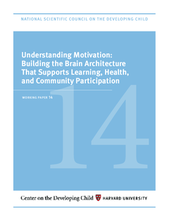This paper explores the "complex set of intertwined social and biological factors influences people’s motivation to participate actively and productively in schools, jobs, and communities— and to persevere in the face of setbacks. To unlock this puzzle and ensure that all people have the opportunity to develop motivation to learn, improve skills, and make healthy choices, it would be helpful to understand the underlying mechanisms in the brain that develop in childhood and build the foundation for later complex behavior." The paper describes and defines different types of motivation and how motivation systems are developed, as well as how they can be disrupted. The paper also identifies key brain regions and chemicals involved in motivation and reward. The paper concludes with implications, including implications for parents and caregivers as well as for policymakers.
View the accompanying infographic here.

